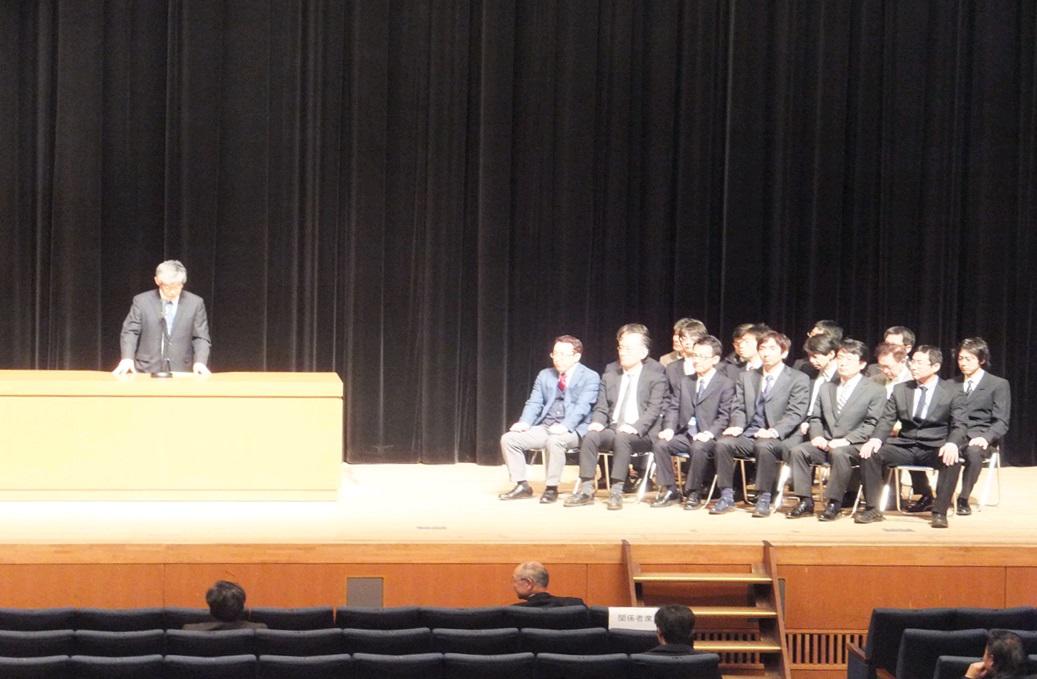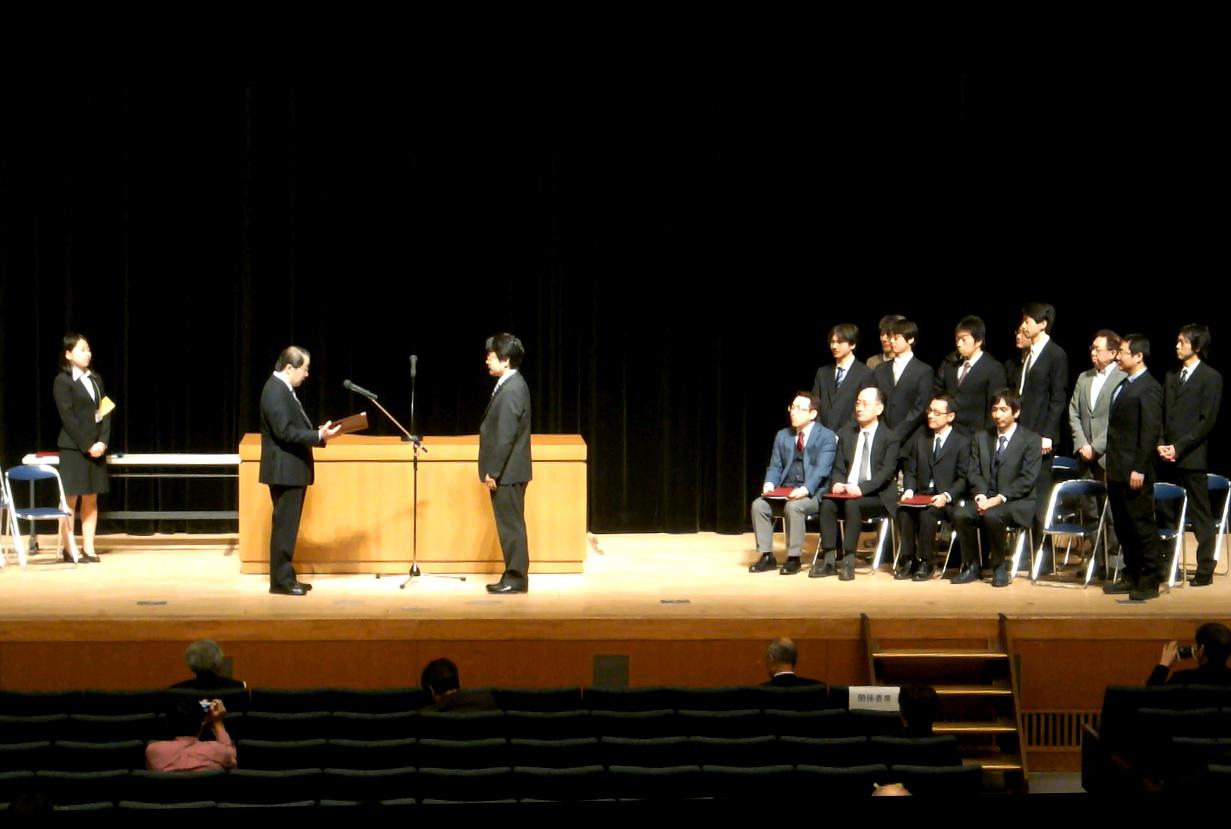Each year, in recognition of important achievements towards the progress of physics, the Physical Society of Japan selects outstanding papers among original research articles published in the Journal of the Physical Society of Japan, Progress of Theoretical Physics, and Progress of Theoretical and Experimental Physics.
The selection committee has chosen the following five papers for the 2016 award from 25 nominations (18 papers) made by the editors of the two journals and representatives of the 19 divisions of the society.


| Title of Article | Metal-Insulator Transitions in Pyrochlore Oxides Ln2Ir2O7 |
|---|---|
| Journal | J. Phys. Soc. Jpn. 80, 094701 (2011) |
| Authors | Kazuyuki Matsuhira, Makoto Wakeshima, Yukio Hinatsu, and Seishi Takagi |
| Citation | The competitive or concerted effect of electron correlation and spin-orbit interaction is an important subject in condensed matter physics. It is drawing the attention of researchers in various fields, including strongly correlated electrons, quantum transport, and the physics of topological phases. This paper provides a basis for research on this subject. The authors reported in their preceding paper that some pyrochlore iridates Ln2Ir2O7 (Ln: lanthanide) exhibit a metal-insulator transition with changes in temperature. They systematically investigated the dependence on Ln and summarized their results in a phase diagram with respect to the ionic radius of the Ln ions. The physics of the Matsuhira phase diagram was later understood by theorists as the competition between the electron correlation and spin-orbit interaction, which led to the prediction of exotic electronic phases such as topological Mott insulators and Weyl semimetals caused by the violation of time-reversal symmetry by magnetism. After that, the material properties of pyrochlore iridates were studied actively across the world. The paper provided an important basis for research on the emergent electronic phases and motivated both theoretical and experimental studies with elaborate experiments and data analysis useful for physical understanding. Hence, we conclude that it deserves the Outstanding Paper Award of the Physical Society of Japan. |
| Title of Article | SmB6: A Promising Candidate for a Topological Insulator |
|---|---|
| Journal | J. Phys. Soc. Jpn. 80, 123710 (2011) |
| Author | Tetsuya Takimoto |
| Citation | SmB6 is known to be a Kondo insulator, in which the quantum correlation effect plays an important role in forming the electronic structure. After the discovery of topological insulators, it was conjectured that SmB6 is also a topological insulator, that is, the correlation effect causes the system to have a finite topological number. In the present paper, the author calculated the Z2 topological number for SmB6 to be 1, showing that SmB6 is a topological insulator. For the calculation, he developed a highly reliable theoretical model that reproduces the result of band calculation and considers the effect of second-nearest neighbor sites ina tight-binding approximation (a periodic Anderson model) as well as the correlation effect. The paper provided not only the first calculation of the topological number in a Kondo insulator but also reasonable answers to longstanding questions regarding low-temperature residual conductance and the response to the magnetic field with the existence of surface metallic states, which is a common property of topological insulators. It presented a theoretical basis for many subsequent theoretical works and motivated detailed experiments on low-temperature transport and angle-resolved photoemission spectroscopy, which proved the consequences of the theory. The topological aspects of strongly correlated systems are becoming increasingly important in condensed matter physics, and the paper should attract further attention from researchers. The paper resolved important experimental and theoretical problems of the Kondo insulator and stimulated further works in the field. Hence, we conclude that it deserves the Outstanding Paper Award of the Physical Society of Japan. |
| Title of Article | Superconductivity Induced by Bond Breaking in the Triangular Lattice of IrTe2 |
|---|---|
| Journal | J. Phys. Soc. Jpn. 81, 053701 (2012) |
| Authors | Sunseng Pyon, Kazutaka Kudo, and Minoru Nohara |
| Citation | In the field of superconductivity, considerable effort has been devoted to research new mechanisms beyond the Bardeen-Cooper-Schrieffer (BCS) theory, where electron-phonon interactions play a major role in the Cooper pairing. A typical example is high-temperature superconductivity in copper oxides. In spite of many theoretical proposals, few new mechanisms have been experimentally confirmed. In this paper, the authors reported that a layered transition-metal dichalcogenide IrTe2 exhibits superconductivity by only 3.5% Pt substitution. It was previously known that IrTe2 exhibits an unusual structural transition accompanied by Ir-Ir bond formation at 250 K. The authors successfully obtained superconductivity by breaking this Ir-Ir bond by Pt substitution. In many exotic superconductors, superconductivity occurs when some order that causes electron localization is suppressed. This suggests that quantum fluctuation near a "quantum critical point" acts as a glue for Cooper pairing. In this context, there is a possibility that the superconductivity in (Ir,Pt)Te2, which is induced by suppressing the structural phase transition related to Ir-orbital ordering, is mediated by orbital fluctuations. This work, suggesting a new superconductivity mechanism, is highly appreciated. Other contributions of this study are (i) to indicate a new strategy of material design (creating superconductivity by chemical bond breaking), (ii) to refute the established idea that Te-compounds with a wide 5p band should be simple metals, and (iii) to discover a route to explore new phenomena and physics resulting from the hybridization of Te 5p and heavy-transition-metal 5d bands. Several studies were strongly motivated and influenced by this work. Hence, we conclude that this paper deserves the Outstanding Paper Award of the Physical Society of Japan. |
| Title of Article | Observation of tau neutrino appearance in the CNGS beam with the OPERA experiment |
|---|---|
| Journal | Prog. Theor. Exp. Phys. 2014, 101C01 (2014) |
| Authors | OPERA Collaboration N. Agafonova, A. Aleksandrov, A. Anokhina, S. Aoki, A. Ariga, T. Ariga, T. Asada, D. Bender, A. Bertolin, C. Bozza, R. Brugnera, A. Buonaura, S. Buontempo, B. Büttner, M. Chernyavsky, A. Chukanov, L. Consiglio, N. D'Ambrosio, G. de Lellis, M. de Serio, P. Del Amo Sanchez, A. Di Crescenzo, D. Di Ferdinando, N. Di Marco, S. Dmitrievski, M. Dracos, D. Duchesneau, S. Dusini, T. Dzhatdoev, J. Ebert, A. Ereditato, R. A. Fini, T. Fukuda, G. Galati, A. Garfagnini, G. Giacomelli, C. Goellnitz, J. Goldberg, Y. Gornushkin, G. Grella, M. Guler, C. Gustavino, C. Hagner, T. Hara, T. Hayakawa, A. Hollnagel, B. Hosseini, H. Ishida, K. Ishiguro, K. Jakovcic, C. Jollet, C. Kamiscioglu, M. Kamiscioglu, T. Katsuragawa, J. Kawada, H. Kawahara, J. H. Kim, S. H. Kim, N. Kitagawa, B. Klicek, K. Kodama, M. Komatsu, U. Kose, I. Kreslo, A. Lauria, J. Lenkeit, A. Ljubicic, A. Longhin, P. Loverre, M. Malenica, A. Malgin, G. Mandrioli, T. Matsuo, V. Matveev, N. Mauri, E. Medinaceli, A. Meregaglia, M. Meyer, S. Mikado, M. Miyanishi, P. Monacelli, M.C. Montesi, K. Morishima, M. T. Muciaccia, N. Naganawa, T. Naka, M. Nakamura, T. Nakano, Y. Nakatsuka, K. Niwa, S. Ogawa, N. Okateva, A. Olshevsky, T. Omura, K. Ozaki, A. Paoloni, B. D. Park, I. G. Park, L. Pasqualini, A. Pastore, L. Patrizii, H. Pessard, C. Pistillo, D. Podgrudkov, N. Polukhina, M. Pozzato, F. Pupilli, M. Roda, T. Roganova, H. Rokujo, G. Rosa, O. Ryazhskaya, O. Sato, A. Schembri, I. Shakiryanova, T. Shchedrina, A. Sheshukov, H. Shibuya, T. Shiraishi, G. Shoziyoev, S. Simone, M. Sioli, C. Sirignano, G. Sirri, M. Spinetti, L. Stanco, N. Starkov, S. M. Stellacci, M. Stipcevic, P. Strolin, S. Takahashi, M. Tenti, F. Terranova, V. Tioukov, S. Tufanli, A. Umemoto, P. Vilain, M. Vladimirov, L. Votano, J. L. Vuilleumier, G. Wilquet, B. Wonsak, C. S. Yoon, I. Yaguchi, M. Yoshimoto, S. Zemskova and A. Zghiche |
| Citation | Neutrino oscillation is a phenomenon where one type (or "flavor") of neutrinos oscillate into a different type of neutrinos over time. There are three flavors of neutrinos: electron neutrinos, muon neutrinos, and tau neutrinos. There are two types of measurements: a "disappearance measurement," in which the change (or decrease) of the number of neutrinos of the original flavor is observed; and an "appearance measurement," in which the neutrinos of a different flavor are positively observed after neutrino oscillation. This 2014 article reported the appearance measurement of tau neutrinos being oscillated from muon neutrinos for the first time with sufficient statistical significance. Appearance measurements are generally difficult; thus far, only one other experiment--the Tokai-to-Kamioka (T2K) experiment--has measured the oscillation from muon neutrinos into electron neutrinos. Although the experimental achievements regarding neutrino oscillation, which received the 2015 Nobel Physics Award, used neutrinos from natural sources such as atmospheric neutrinos or solar neutrinos, this experiment employed accelerator-based neutrinos. The muon neutrino beam produced at the CERN neutrinos to Gran Sasso (CNGS) neutrino beam facility at CERN, Geneva, was provided to the detectors at the Gran Sasso laboratory in Italy, which is located 732 km away from CERN. This experiment is called the "Oscillation Project with Emulsion-tRacking Apparatus (OPERA)" experiment. Thus far, the OPERA collaboration has led to the observation of four events of tau neutrinos and the significance of signals with a confidence level of 4.2 sigma. The experimental challenge of the OPERA experiment is to identify a tau lepton that is produced by a tau neutrino with a high confidence level. This is difficult because the tau lepton has a very short lifetime, and therefore, a very short flight path. The OPERA collaboration adopted a novel technique of nuclear emulsion. The group at Nagoya University has a long history of developing nuclear emulsion techniques. The contribution of the group is significant and is leading the OPERA collaboration. Without their contribution, the OPERA experiment would not be conducted successfully. In summary, this article reported four events of neutrino oscillation from muon neutrinos into tau neutrinos with a confidence level of 4.2 sigma, providing significant insights in elementary particle physics, including neutrino masses and neutrino mixing. Therefore, we conclude that this article deserves the Outstanding Paper Award of the Physical Society of Japan. |
| Title of Article | The Nature of Primordial Fluctuations from Anisotropic Inflation |
|---|---|
| Journal | Prog. Theor. Phys. 123, 1041 (2010) |
| Authors | Masa-aki Watanabe, Sugumi Kanno and Jiro Soda |
| Citation | The inflationary universe scenario is believed to naturally explain the homogeneity and isotropy of the universe. Recent detailed observation of the cosmic microwave radiation background (CMB) revealed correlations among the temperature fluctuations in the CMB beyond the horizon at the time of recombination, which supports the existence of an inflationary period in the early universe. Although many models of inflation have been proposed, it is not easy to determine the correct model, owing to the lack of sufficient physical quantities from observation. In 2008, the authors indicated the possibility of anisotropic inflation, whereby the universe expands anisotropically while maintaining homogeneity. They proposed the first concrete model of a vector field coupled to an inflation field that generates anisotropic inflation self-consistently. They clarified how to obtain information about the theory underlying the inflation from observations of the CMB and gravitational waves. In this paper, the authors provided the first quantitative analysis of the nature of primordial fluctuations due to anisotropic inflation. They analyzed the evolution of scalar, vector, and tensor fluctuations and showed the couplings between curvature perturbations, vector waves, and gravitational waves. They derived predictions about the polarization of primordial gravitational waves to be tested in future. After the paper was published, there were reports by the Wilkinson microwave anisotropy probe and Planck satellite observation indicating anisotropy in fluctuations in the CMB, which triggered great attention to the subject among the community. The importance and relevance of the paper will certainly increase the research on inflation through the observation of CMB and gravitational waves in the coming years. Although more than five years have passed since its publication, the significance of the paper is undoubtedly increasing. The paper deserves the Outstanding Paper Award of the Physical Society of Japan. |
